Supply and exhaust ventilation systems: a comparative overview of various types of equipment
The natural air circulation system often fails - its performance depends on natural factors and the use of sealed glass units. Forced ventilation is deprived of these shortcomings.
For the normalization of air exchange, a supply and exhaust unit is used - a practical and effective solution. The variety of climatic equipment allows you to choose a model for specific operating conditions. However, to decide on a suitable device is sometimes problematic, agree?
We will help you to resolve this issue. The article provides information on the principles of operation and features of the operation of different types of supply and exhaust units. To facilitate the selection, we outlined the main characteristics and parameters of the devices, which must be taken into account when buying.
The content of the article:
Components of forced ventilation
The supply and exhaust module is the main component of the ventilation system with motivation. The installation provides normalized air circulation in a confined space - the supply of clean flows and the withdrawal of waste masses.
The ventilation module is a set of equipment enclosed in a single housing (monoblock unit) or assembled from typesetting elements.
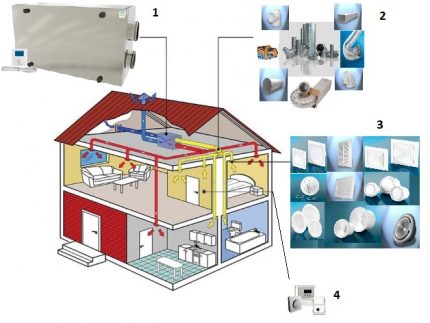
The design of the supply and exhaust unit without fail includes the following elements:
- Fan. The basic component for the operation of an artificial air exchange system.Radial fans with a high air pressure are installed in the PVU with an extensive network of ducts. The use of axial models is permissible in portable PVU.
- Air valve. It is installed behind the external grill and prevents the flow of air from the outside when the system is off. If it is absent, cold streams will leak into the room in winter
- Air duct. Two lines of channels are involved in the system: one - supply, and the second - air discharge. Both networks pass through the PVU. A supply fan is connected to the first duct, and an exhaust fan to the second, respectively.
- Automation. The operation of the installation is regulated by an integrated automation system that responds to sensor readings and user-specified parameters.
- Filters Integrated filtration is used to clean incoming masses. A coarse filter is placed at the inlet of the supply air duct; its task is to retain fluff, insects and dust particles.
The primary purpose of primary cleaning is to protect the internal components of the system. For more “fine” filtration, a photocatalytic, coal or other type of barrier is installed in front of the air distributors.
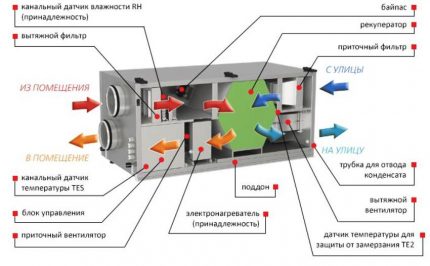
Some complexes are equipped with additional functionality: cooling, air conditioning, humidification, multi-stage air purification and ionization system.
The principle of operation of the supply and exhaust complex
The PVU duty cycle is based on a dual-circuit transportation scheme.
The entire ventilation process can be divided into several stages:
- Air intake from the street, its cleaning and supply to the distributors through the duct.
- The entry of contaminated masses into the exhaust duct and their subsequent transportation to the outlet grill.
- Exhaust waste jets out.
The circulation scheme can be supplemented by the stages of transfer of thermal energy between two streams, additional heating of the incoming air, etc.
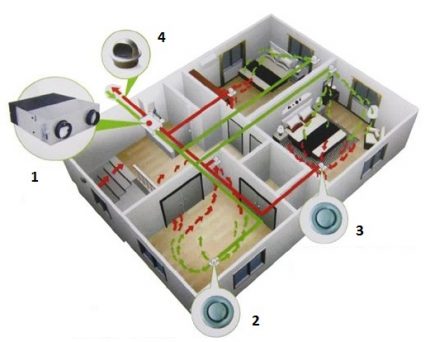
The operation of the forced system provides a range of advantages compared to natural air exchange:
- maintaining set targets - Sensors respond to a change in the atmosphere and adjust the operation mode of the PES;
- inbound filtering and the possibility of its processing - heating, cooling, moistening;
- saving heating costs - relevant for devices with recovery.
The disadvantages of using PVU include: the high cost of the ventilation complex, the complexity of installation after the completion of repair and construction works and the noise effect. In monoblock installations, the last minus is eliminated thanks to the use of a soundproof enclosure.
Types of installations: features of the device and operation
Cost, performance, power consumption depend on the functionality of the PES. The variety of models is conditionally divided into the following groups: units with recovery, units with heating and air conditioning. A separate category is “mobile” devices.
Supply and exhaust module with recuperator
Forced ventilation system, in addition to the advantages described above, has a significant drawback - a significant increase in heat loss. Together with the exhaust air, the heat generated by the heating system also “disappears”.
Costs are about 60%. The solution to the problem is the transfer of energy from the exhaust air flow to the supply air.
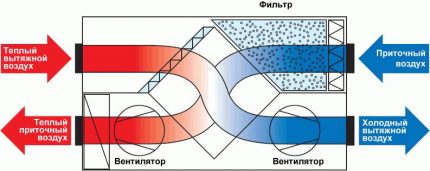
Today, most of the supply and exhaust units are made with recuperators. Despite the high cost of equipment, the feasibility regenerative system economically sound.
The efficiency values of the "heat exchanger":
- 30-60% - low level of heat compensation;
- 60-80% - a good indicator of effectiveness;
- over 80% - high quality heat transfer.
It is interesting that even the presence of a heat exchanger with an efficiency of 30% is more economical than a basic configuration PVU without a heat exchanger. The average payback period of a recuperative ventilation installation is up to 5 years.
The efficiency of the PES, the airflow pattern, the power consumption and the price of the module depend on the design of the recuperator.
There are several types of heat exchangers:
- rotary;
- lamellar;
- heat pipes;
- chamber module;
- glycol unit.
The first two models were widely used.
Rotary recuperator
A cylindrical rotating heat exchanger with corrugated metal plates is placed in the PVU case. During operation, the compartments are alternately filled with multidirectional air flows.
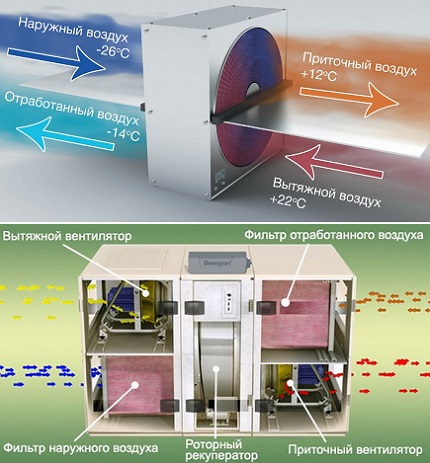
Heat recovery is 60-90%.
Additional benefits:
- partial return of moisture;
- economical power consumption.
The rotation speed of the drum can be adjusted, thereby choosing the intensity of air exchange and the level of efficiency.
Arguments against drum modification:
- a mixture of “mining” to the fresh stream - 3-8%;
- partial transfer of odors back to the room;
- acoustic pressure from a rotating rotor;
- the need for regular maintenance of moving parts;
- large dimensions.
Due to the complexity of the PVU mechanism with a rotary recuperator, they are more expensive than plate modifications.
Plate heat exchanger
Ducts "meet" in a sealed unit with many channels. The compartments are separated by heat-conducting partitions.
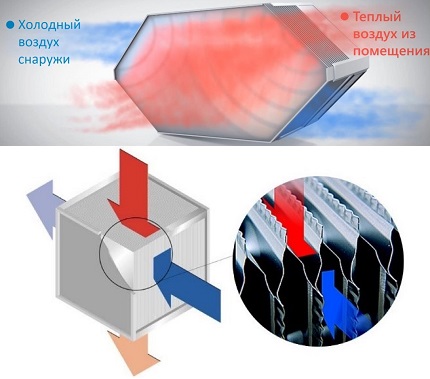
Arguments for":
- supply of clean air without impurities of "mining";
- affordable cost;
- ease of setup and reliability of the module - no moving elements.
Plate converter efficiency - up to 70%. The main disadvantage is the formation of condensate and the appearance of ice in the exhaust duct in winter. Work in the “defrost” mode (redirecting the warm flow to bypass the cassette) reduces the system efficiency by 20%.
Now on the market there are quite a lot of supply and exhaust ventilation systems with heat recovery from various manufacturers. Having a similar set of characteristics, they differ in price, quality, service area and many other criteria.
So, we recommend that you take a closer look at the supply and exhaust ventilation unit with a plate heat exchanger and integrated automation from Naveka, which recently this solution has proven itself in the market due to its reliability and fairly quiet operation. Integrated control using a remote control, monitoring on an external LCD display, setting a work schedule and much more is already immediately built into this unit.
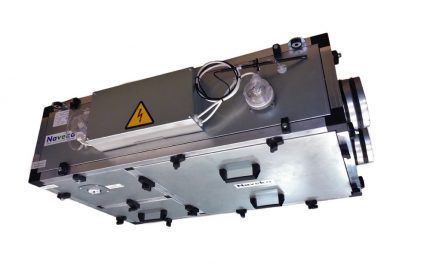
Among other brands, we recommend paying attention to systems with recovery from Mitsubishi, Maico and VENTO.
Energy Saving Heated Units
Recovery alone is often not enough to fully compensate for the temperature difference in the oncoming flows. The built-in air heater takes over this function. In addition, the element protects the heat exchanger from freezing.
In PVU two types of heaters are used: water and electric. Let's consider each in more detail.
Water heating
In the case of a forced ventilation unit there is a radiator with tubes through which the coolant circulates. The coil has a fin to increase the area of contact with passing air jets.
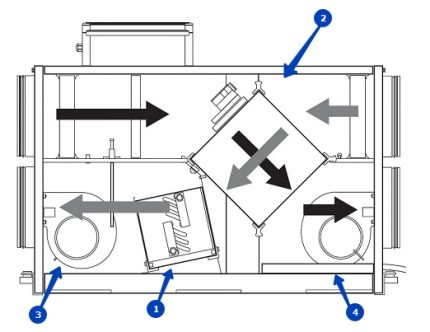
The liquid heating element comes into operation if at the outlet of the recuperator the supplied air is colder than the set temperature.
Electric heater
Installations with an electric air heater can heat the supplied air to higher temperatures than water modifications.
However, an electric heater is more demanding of working conditions:
- air flow rate - 2 m / s or more;
- the temperature of the supplied air is in the range 0-30 ° C, humidity - up to 80%;
- before the heater it is recommended to install an additional filter.
Compared to water heating, an electric module is more expensive in terms of operation - payments for electricity increase.

Air-conditioned complexes
Individual models combine the forced ventilation and air conditioning options. All elements are assembled in a single thermal insulation complex. A striking example of multifunctional technology - a series of installations "Climate".
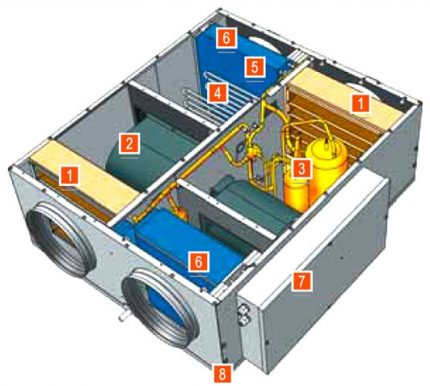
The circuit contains a reversible heat pump - a filled sealed freon circuit connected to heat exchangers on the exhaust and inlet duct.
The operation of the air conditioning unit takes place in two modes:
- Cooling. The heat exchanger on the supply air duct acts as an evaporator and lowers the temperature of the incoming air. In turn, the heat exchanger-condenser is cooled by cool air coming from the room.
- Heat. The exhaust duct recuperator gives off the “exhaust” heat to fresh air masses. An additional heating of the air is possible at the exit from the PVU before being fed into the house.
The mode of operation is set automatically thanks to regulators and sensors that read the parameters of the atmosphere.
Portable channelless installation
An interesting solution for confined spaces is the supply air mobile ventilation units with the ability to clean, heat, and cool the air.
Distinctive features of portable modules:
- lack of bulky air ducts;
- installation inside a ventilated room;
- compact dimensions and the possibility of installation within 2-3 hours;
- multifunctionality: inflow, processing and output of air masses;
- low noise level - within 35 dB;
- lack of drafts.
For the arrangement of decentralized ventilation, it is necessary to install a portable PED in each individual room.
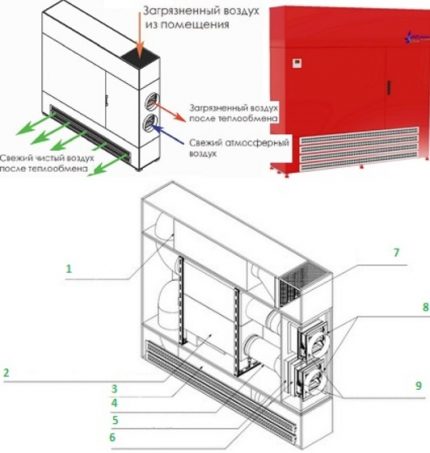
Channelless air handling units are mainly used in public buildings (lecture halls, exercise rooms, training rooms, etc.).
The rating of mobile climatic equipment is given in this article.
Varieties by installation method
There are three options for installing the ventilation module:
- floor;
- wall;
- "Hemming".
Floor mounting is typical for high-performance and bulky ventilation units with an air flow rate of 8,000 cubic meters / h. Despite the vibration isolation of the ventilation sections, a solid foundation is required to install volume modules.
Wall-mounted models are notable for their low productivity - up to 1500 cubic meters per hour and compact dimensions. Installation is carried out by anchoring to the wall, connecting ducts from above. The unit can be placed in a technical room (balcony, bathroom, dressing room).

The main advantage of suspended models is flush mounting. However, to install the unit in an operated room, it is necessary to partially “use” the ceiling height.
Basic parameters for choosing a ventilation unit
Arrangement and installation of ventilation systems requires capital investment and considerable labor costs. Therefore, the approach to choosing the “heart” of the ventilation system is based on accurate calculations and analysis of a number of parameters.
Assessment and calculation of technical characteristics
First of all, you should decide on the appropriate values of performance and static pressure.
Performance
The calculation of the installation is based on the norms of air exchange according to SNiP, the purpose of the room, the area of service and the number of residents.
It is necessary to perform two calculations (by the number of people and the rate of air exchange), compare the indicators and select the highest value.

An example of determining the performance (L) for a house under given conditions:
- the number of family members - 3 people;
- house area - 70 sq.m;
- ceiling height - 3 m.
Formula 1. The calculation of the number of residents:
L = N * norm,
Where:
- N - number of residents;
- norm - air consumption (not less than 40 cubic meters / h).
L = 3 * 40 = 120 m3 / h.
Formula 2. The calculation of the frequency of air exchange:
L = S * H * n,
Where:
- S - area;
- H - height;
- n - normalized rate of air exchange.
L = 70 * 3 * 1.5 = 315 m3 / h.
Conclusion: to ensure sufficient air circulation, installation with a capacity of at least 315 cubic meters / h is required.
Typical indicators of ventilation installations:
- 100-500 m3 / h - apartments and separate rooms;
- 500-2000 m3 / h - private households, cottages;
- 1000-10000 cubic m / h - industrial buildings, workshops, offices.
Static pressure
The value indicates the pressure created by the fan to provide resistance to the air circulation path. An accurate calculation of the static pressure requires taking into account the resistance of all network elements.
"Manual" calculation without the appropriate experience is difficult to perform. Specialists use a software package like MagiCad.
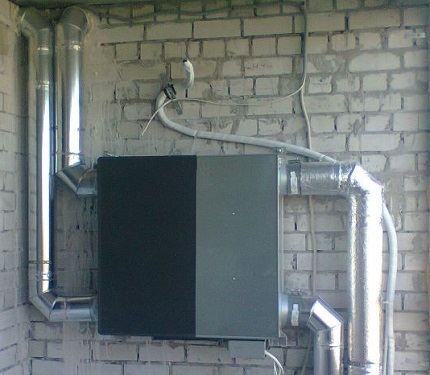
The data given are relevant specifically for modular ventilation units, rather than typesetting complexes, where pressure reduction on the air valve, air heater, filter and other components should be taken into account.
In addition to the indicated parameters, you should evaluate:
- Energy efficiency. For each of the possible models, it is necessary to calculate the cost of electricity for 1 year, taking into account the operating mode in winter and summer. The energy class indicates the ratio of energy expended to the amount of heat generated.
- Recuperator efficiency. It is necessary to compare the values of efficiency in different modes of operation of the PES. A high efficiency indicator for heat exchangers with a double plate cassette and an intermediate zone - the efficiency reaches 70-90%.
- Heater power. A typical indicator for domestic air handling units is 3-5 kW.
It is better to give preference to models with the ability to automatically lower the fan speed to adjust the load on the network.
Noise level and degree of filtration
Acoustic power shows how “loud” the operation of the assembled unit will be.
The sound effect is determined by two quantities:
- Lwa - degree of acoustic power;
- Lpa - sound pressure level.
Assess the real "noise" should be on the first indicator. Different manufacturers can measure acoustic power using different methods, so the same values sometimes have a distinctive result in practice.
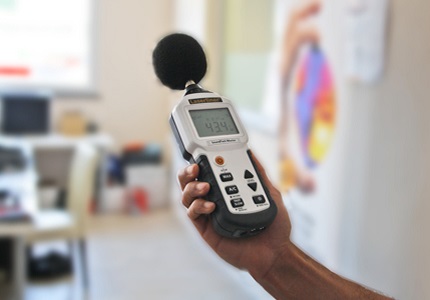
The quality of the incoming air depends on the used cleaning systems.
Possible filtration steps:
- a barrier against coarse street dust, wool and fluff - rough cleaning with G4, G3 filters with an efficiency of 90%;
- protection against fine dust in 1 micron - filtration class F7-F9;
- absolute cleaning, providing a barrier against particles of 0.3 microns - HEPA filters (H10-H14), efficiency - 99.5%.
For residential buildings, the first two stages of cleaning are sufficient. Highly effective filtration is used in medical facilities, premises for the production of drugs, food, electronics.
Convenience of operation: necessary functionality
Domestic PVUs are equipped with an integrated automation system, a control panel, an LCD display with the output of all air exchange parameters. In addition to the basic options (adjusting the fan speed, temperature), practical functions are welcome.
Timer. Scenario management will optimize the mode of operation for a specific time of day or day of the week.
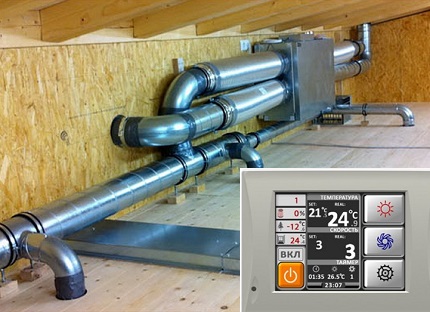
Restart The ability to automatically turn on and save the specified parameters in the event of a power failure.
Filter clogging indicator. A convenient option is a notification about the replacement of the filter element. High-tech models are equipped with sensors for changing the pressure at the inlet of the air filter - with pollution, the pressure drop increases.
Self-diagnosis. Any equipment fails over time. It is useful if the automation "notifies" of a malfunction that has occurred - this will help to fix and fix the problem in a timely manner.
Conclusions and useful video on the topic
Energy-saving ventilation system with recuperation of suspended type Daikin VAM / 800FB:
The device, features and installation technology of a portable supply and exhaust module Vents Micro 60 / A3:
PVU 400 from Ventrum with electric heater and rotary heat exchanger:
Arrangement of ventilation with the help of a supply and exhaust module is used in rooms of various purposes and sizes.
Ensuring high-quality air exchange depends on competent calculation and selection of climatic equipment. If you have doubts about your own strengths, then it is better to contact professionals to determine the parameters and develop a project.
Is there anything to supplement, or have questions about choosing a supply and exhaust system? You can leave comments on the publication and participate in the discussion of the material - the contact form is in the lower block.

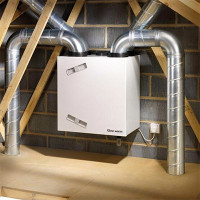 Supply and exhaust ventilation with heat recovery: operating principle, an overview of the advantages and disadvantages
Supply and exhaust ventilation with heat recovery: operating principle, an overview of the advantages and disadvantages  Supply and exhaust ventilation: principle of operation and features of the arrangement
Supply and exhaust ventilation: principle of operation and features of the arrangement 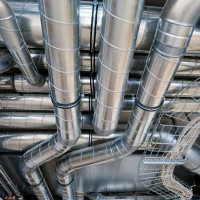 Types of ventilation pipes: a detailed comparative overview of ventilation pipes
Types of ventilation pipes: a detailed comparative overview of ventilation pipes 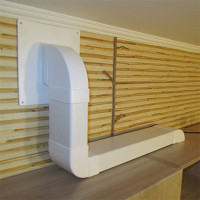 Plastic ducts for hoods: overview of types + installation rules
Plastic ducts for hoods: overview of types + installation rules 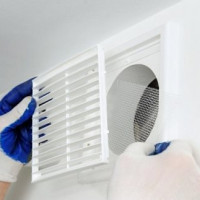 What to do if the ventilation in the apartment and the house does not work? Overview of possible causes and solutions
What to do if the ventilation in the apartment and the house does not work? Overview of possible causes and solutions 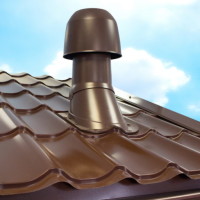 How to increase traction in ventilation: an overview of methods and devices for enhancing traction
How to increase traction in ventilation: an overview of methods and devices for enhancing traction  How much does it cost to connect gas to a private house: the price of organizing gas supply
How much does it cost to connect gas to a private house: the price of organizing gas supply  The best washing machines with dryer: model rating and customer tips
The best washing machines with dryer: model rating and customer tips  What is the color temperature of light and the nuances of choosing the temperature of the lamps to suit your needs
What is the color temperature of light and the nuances of choosing the temperature of the lamps to suit your needs  Replacement of a geyser in an apartment: replacement paperwork + basic norms and requirements
Replacement of a geyser in an apartment: replacement paperwork + basic norms and requirements